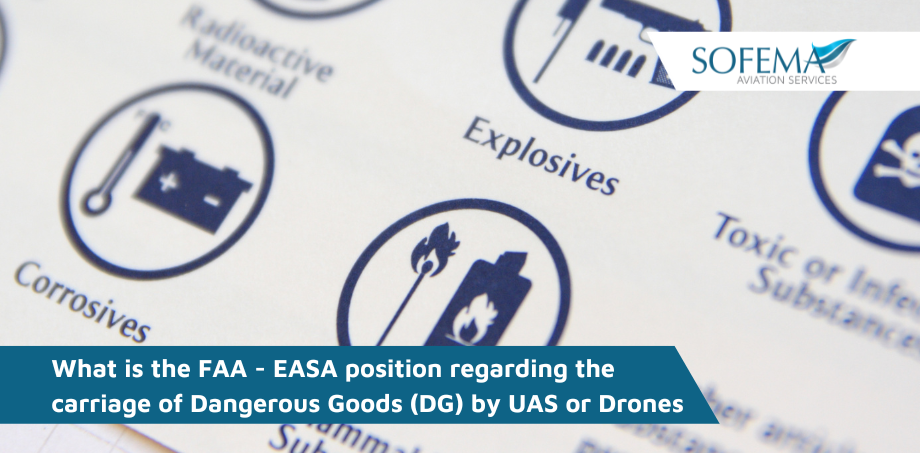Sofema Aviation Services (SAS) www.sassofia.com looks at the requirements related to the carriage of Dangerous Goods which currently exist within the FAA & EASA environment.
FAA Introduction – DG Requirements
Individuals or entities that transport dangerous goods via Unmanned Aircraft Systems (UAS) or drones must meet the same regulatory requirements of manned aircraft. A brief description of applicable regulations as they apply to drones is listed below:
- Many UAS operations may be conducted under 14 CFR Part 107, known as the Small UAS Rule. Package delivery operations may be permitted under specific conditions.
NOTE – However, the carriage/transportation of dangerous goods under Part 107 is prohibited at all times, and is not subject to waiver.
- 14 CFR Part 135 certification is the regulatory path that small drones must follow to carry the property of another for compensation beyond visual line of sight. Part 135 UAS or drone certificate holders must develop dangerous goods training programs and manuals as part of the 14 CFR Part 135 Air Carrier and Operator Certification Process. During the Part 135 Certification process, AXH and the Office of Aviation Safety (AVS) work collaboratively with applicants to ensure all safety requirements are met. These requirements are the same as what is expected for traditional, crewed Part 135 on-demand certificate holders.
- We support the FAA UAS Integration Pilot Program, as well as the FAA’s BEYOND program, by working with industry, state, local, and tribal governments to help realize the benefits of drones while informing the development of a more mature drone regulatory framework.
- 14 CFR Part 137 applies to drones used in agricultural operations or other special aircraft operations where dangerous goods are dispensed in flight. To obtain authorization to operate under this regulation, contact your local Flight Standards District Office (FSDO) to start the certification process. They will work with the Office of Hazardous Materials Safety (AXH) as needed.
EASA Introduction DG Requirements
Which operators have to establish and maintain dangerous goods training programmes? Which training programmes should be approved by the authority?
The rule reference is ORO.GEN.110 (j). All operators subject to ORO.GEN.005 must establish and maintain dg training programmes in all cases.
The approval, however, is only necessary if:
- It is a CAT operation.
- The operator is transporting dangerous goods and performing:
o Commercial specialised operations:
o Non-commercial operations with complex motor-powered aircraft; or
o Non-commercial specialised operations with complex motor-powered aircraft.
There is also an alleviation in ORO.GEN.110 (k) for operators of sailplanes, balloons, and certain single-engined propeller-driven airplanes and single-engined other-than motor-powered helicopters of 5700 Kg or less of MCTM and an MOPSC of 5 or less operating in a flight taking off and landing at the same aerodrome/operating site under VFR by day, where the requirement is that operators shall ensure that the flight crew has received an appropriate training or briefing to enable them to recognize undeclared dangerous goods brought on-board by passengers or as cargo (refer to the rule for more information).
Next Steps
Follow this link to our Library to find & Download related documents for Free.
Sofema Aviation Services www.sassofia.com and Sofema Online www.sofemaonline.com provide Regulatory & Vocational Compliant Classroom, Webinar & Online training. For additional details, please visit our websites or email team@sassofia.com
Tags:
aviation, Dangerous Goods, EASA, EASA requirements, FAA, Flight Standards District Office (FSDO), Packing Requirements, Regulatory Requirements, Requirements, SAS blogs, Unmanned Aircraft Systems (UAS)




